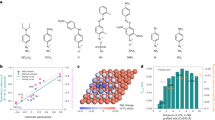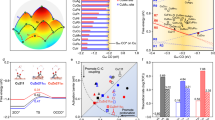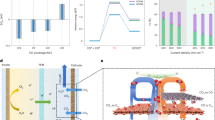Abstract
Unlike energy efficiency and selectivity challenges, the kinetic effects of impure or intentionally mixed CO2 feeds on the catalytic reactivity of the direct electrochemical CO2 reduction reaction (CO2RR) have been poorly studied. Given that industrial CO2 feeds are often contaminated with CO, a closer investigation of the CO2RR under CO2/CO co-feed conditions is warranted. Here, we report mechanistic insights into the CO2RR reactivity of CO2/CO co-feeds on Cu-based nanocatalysts. Kinetic isotope-labelling experiments—performed in an operando differential electrochemical mass spectrometry capillary flow cell with millisecond time resolution—showed an unexpected enhanced production of C2H4, with a yield increase of almost 50%, from a cross-coupled 12CO2–13CO reactive pathway. The results suggest the absence of site competition between CO2 and CO molecules on the reactive surface at the reactant-specific sites. The practical significance of sustained local interfacial CO partial pressures under CO2 depletion is demonstrated by metallic/non-metallic Cu/Ni–N-doped carbon tandem catalysts. Our findings show the mechanistic origin of improved C2 product formation under co-feeding, but also highlight technological opportunities of impure CO2/CO process feeds for H2O/CO2 co-electrolysers.
This is a preview of subscription content, access via your institution
Access options
Access Nature and 54 other Nature Portfolio journals
Get Nature+, our best-value online-access subscription
$29.99 / 30 days
cancel any time
Subscribe to this journal
Receive 12 print issues and online access
$259.00 per year
only $21.58 per issue
Buy this article
- Purchase on Springer Link
- Instant access to full article PDF
Prices may be subject to local taxes which are calculated during checkout




Similar content being viewed by others
Data availability
The data that support the plots within this paper and other findings of this study are available from the corresponding author on reasonable request.
References
Le Quéré, C. et al. Global carbon budget 2017. Earth Syst. Sci. Data 10, 405–448 (2018).
Armstrong, R. C. et al. The frontiers of energy. Nat. Energy 1, 15020 (2016).
Rendón-Calle, A., Builes, S. & Calle-Vallejo, F. A brief review of the computational modeling of CO2 electroreduction on Cu electrodes. Curr. Opin. Electrochem. 9, 158–165 (2018).
Reske, R., Mistry, H., Behafarid, F., Roldan Cuenya, B. & Strasser, P. Particle size effects in the catalytic electroreduction of CO2 on Cu nanoparticles. J. Am. Chem. Soc. 136, 6978–6986 (2014).
Li, C. W. & Kanan, M. W. CO2 reduction at low overpotential on Cu electrodes resulting from the reduction of thick Cu2O films. J. Am. Chem. Soc. 134, 7231–7234 (2012).
Handoko, A. D. et al. Mechanistic insights into the selective electroreduction of carbon dioxide to ethylene on Cu2O-derived copper catalysts. J. Phys. Chem. C. 120, 20058–20067 (2016).
Loiudice, A. et al. Tailoring copper nanocrystals towards C2 products in electrochemical CO2 reduction. Angew. Chem. Int. Ed. 55, 5789–5792 (2016).
Mistry, H. et al. Highly selective plasma-activated copper catalysts for carbon dioxide reduction to ethylene. Nat. Commun. 7, 12123 (2016).
Lum, Y. & Ager, J. W. Evidence for product-specific active sites on oxide-derived Cu catalysts for electrochemical CO2 reduction. Nat. Catal. 2, 86–93 (2018).
Hori, Y., Murata, A. & Takahashi, R. Formation of hydrocarbons in the electrochemical reduction of carbon dioxide at a copper electrode in aqueous solution. J. Chem. Soc. Faraday Trans. 85, 2309–2326 (1989).
Hori, Y., Kikuchi, K., Murata, A. & Suzuki, S. Production of methane and ethylene in electrochemical reduction of carbon dioxide at copper electrode in aqueous hydrogencsrbonate solution. Chem. Lett. 15, 897–898 (1986).
Dinh, C. et al. CO2 electroreduction to ethylene via hydroxide-mediated copper catalysis at an abrupt interface. Science 360, 783–787 (2018).
Somorjai, G. A. Catalysis on the atomic scale. Catal. Rev. 18, 173–197 (1978).
Peterson, A. A. & Nørskov, J. K. Activity descriptors for CO2 electroreduction to methane on transition-metal catalysts. J. Phys. Chem. Lett. 3, 251–258 (2012).
Peterson, A. A., Abild-Pedersen, F., Studt, F., Rossmeisl, J. & Nørskov, J. K. How copper catalyzes the electroreduction of carbon dioxide into hydrocarbon fuels. Energy Environ. Sci. 3, 1311–1315 (2010).
Kortlever, R., Shen, J., Schouten, K., Calle-Vallejo, F. & Koper, M. T. M. Catalysts and reaction pathways for the electrochemical reduction of carbon dioxide. J. Phys. Chem. Lett. 6, 4073–4082 (2015).
Huang, Y., Handoko, A. D., Hirunsit, P. & Yeo, B. S. Electrochemical reduction of CO2 using copper single-crystal surfaces: effects of CO* coverage on the selective formation of ethylene. ACS Catal. 7, 1749–1756 (2017).
Wang, L. et al. Electrochemical carbon monoxide reduction on polycrystalline copper: effects of potential, pressure, and pH on selectivity toward multicarbon and oxygenated products. ACS Catal. 8, 7445–7454 (2018).
Mackay, D. & Shui, W. Y. A critical review of Henry’s law constants for chemicals of environmental interest. J. Phys. Chem. Ref. Data 10, 1175–1199 (1981).
Tang, W. et al. The importance of surface morphology in controlling the selectivity of polycrystalline copper for CO2 electroreduction. Phys. Chem. Chem. Phys. 14, 76–81 (2012).
Feng, X., Jiang, K., Fan, S. & Kanan, M. W. Grain-boundary-dependent CO2 electroreduction activity. J. Am. Chem. Soc. 137, 4606–4609 (2015).
Manthiram, K., Beberwyck, B. J. & Alivisatos, A. P. Enhanced electrochemical methanation of carbon dioxide with a dispersible nanoscale copper catalyst. J. Am. Chem. Soc. 136, 13319–13325 (2014).
Wang, X., Varela, A. S., Bergmann, A., Kühl, S. & Strasser, P. Catalyst particle density controls hydrocarbon product selectivity in CO2 electroreduction on CuOx. ChemSusChem 10, 4642–4649 (2017).
Calle-Vallejo, F. & Koper, M. T. M. Theoretical considerations on the electroreduction of CO to C2 species on Cu(100) electrodes. Angew. Chem. 125, 7423–7426 (2013).
Pérez-Gallent, E., Figueiredo, M. C., Calle-Vallejo, F. & Koper, M. T. M. Spectroscopic observation of a hydrogenated CO dimer intermediate during CO reduction on Cu(100) electrodes. Angew. Chem. 129, 3675–3678 (2017).
Schouten, K., Kwon, Y., van der Ham, C., Qin, Z. & Koper, M. T. M. A new mechanism for the selectivity to C1 and C2 species in the electrochemical reduction of carbon dioxide on copper electrodes. Chem. Sci. 2, 1902–1909 (2011).
Heyes, J., Dunwell, M. & Xu, B. CO2 reduction on Cu at low overpotentials with surface-enhanced in situ spectroscopy. J. Phys. Chem. C. 120, 17334–17341 (2016).
Roberts, F. S., Kuhl, K. P. & Nilsson, A. High selectivity for ethylene from carbon dioxide reduction over copper nanocube electrocatalysts. Angew. Chem. Int. Ed. 54, 5179–5182 (2015).
Kas, R. et al. Electrochemical CO2 reduction on Cu2O-derived copper nanoparticles: controlling the catalytic selectivity of hydrocarbons. Phys. Chem. Chem. Phys. 16, 12194–12201 (2014).
Schreier, M., Yoon, Y., Jackson, M. N. & Surendranath, Y. Competition between H and CO for active sites governs copper-mediated electrosynthesis of hydrocarbon fuels. Angew. Chem. Int. Ed. 57, 10221–10225 (2018).
Huang, J., Mensi, M., Oveisi, E., Mantella, V. & Buonsanti, R. Structural sensitivities in bimetallic catalysts for electrochemical CO2 reduction revealed by Ag-Cu nanodimers. J. Am. Chem. Soc. 141, 2490–2499 (2019).
Morales-Guio, C. G. et al. Improved CO2 reduction activity towards C2+ alcohols on a tandem gold on copper electrocatalyst. Nat. Catal. 1, 764–771 (2018).
Lum, Y. & Ager, J. W. Sequential catalysis controls selectivity in electrochemical CO2 reduction on Cu. Energy Environ. Sci. 11, 2935–2944 (2018).
Ju, W. et al. Understanding activity and selectivity of metal-nitrogen-doped carbon catalysts for electrochemical reduction of CO2. Nat. Commun. 8, 944 (2017).
Möller, T. et al. Efficient CO2 to CO electrolysis on solid Ni–N–C catalysts at industrial current densities. Energy Environ. Sci. 12, 640–647 (2019).
Acknowledgements
The authors acknowledge support from the EnCO2re project. P.S., X.W and W.J. are grateful for partial support from the German Federal Ministry of Education and Research (Bundesministerium für Bildung und Forschung) under grant no. 03SF0523A–“CO2EKAT”. The authors thank S. Selve and U. Gernert at Zentraleinrichtung für Elektronenmikroskopie and I. Ohnishi at JEOL Ltd for support with the microscopy measurements. A.B. and J.R. acknowledge research grant no. 9455 from VILLUM FONDEN (V-SUSTAIN) and the Innovation Fund Denmark (grand solution ProActivE 5124-00003A). P.S. acknowledges support from the Cluster of Excellence “UniSysCat” funded by the Deutsche Forschungsgemeinschaft.
Author information
Authors and Affiliations
Contributions
X.W., J.F.d.A. and P.S. conceived and designed the project and wrote the manuscript. X.W. carried out the materials synthesis, characterization and electrochemical evaluation. J.F.d.A. conducted the DEMS measurement and analysed the results. W.J. and A.B. participated in the discussion of the electrochemical results and reaction mechanism sections. H.S. performed the HE-XRD measurement and provided help with the data analysis. X.W. and S.K. performed the TEM characterizations. All authors read and commented on the manuscript.
Corresponding author
Ethics declarations
Competing interests
The authors declare no competing interests.
Additional information
Publisher’s note Springer Nature remains neutral with regard to jurisdictional claims in published maps and institutional affiliations.
Supplementary information
Supplementary information
Supplementary Tables 1–5, Figs. 1–25, experimental details and refs. 1–3.
Rights and permissions
About this article
Cite this article
Wang, X., de Araújo, J.F., Ju, W. et al. Mechanistic reaction pathways of enhanced ethylene yields during electroreduction of CO2–CO co-feeds on Cu and Cu-tandem electrocatalysts. Nat. Nanotechnol. 14, 1063–1070 (2019). https://doi.org/10.1038/s41565-019-0551-6
Received:
Accepted:
Published:
Issue Date:
DOI: https://doi.org/10.1038/s41565-019-0551-6
This article is cited by
-
Design and diagnosis of high-performance CO2-to-CO electrolyzer cells
Nature Chemical Engineering (2024)
-
Electrochemical Carbon Dioxide Reduction in Acidic Media
Electrochemical Energy Reviews (2024)
-
In situ reconstruction induced oxygen-deficient multiphase Cu based species hybridized with Ni single atoms as tandem platform for CO2 electroreduction
Nano Research (2024)
-
The reformation of catalyst: From a trial-and-error synthesis to rational design
Nano Research (2024)
-
Localizing vitamin-C through nanoconfinement enables high-rate CO2 electrolysis to ethylene
Science China Materials (2024)



